  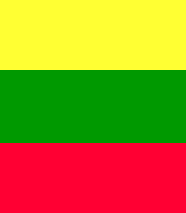 |
Estonia | Part 2 |
| Latvia | ||
| Lithuania |
Friday 5 September 2014
Pärnu - Riga: 181 km / 112 mi; 2:36 u.
We drive in a southerly direction along the coast to the border with
Latvia. At the border we can move on without any formalities. In Latvia the
roads are in a noticeably worse condition than in Estonia. Estonian roads
are perfectly smooth whereas the Latvian ones are 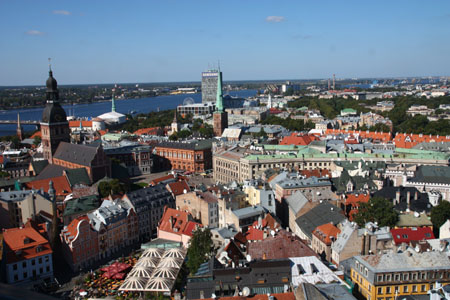 narrower
and full of bumps, potholes and a patchwork of repairs. We arrive around 11
am in Riga, capital of Latvia. By accident we drive past the
Gallery Park Hotel
and it takes a lot of effort to get back there again because of
all the one way traffic streets. Once at the Hotel we are received
with extreme courtesy and we immediately get a tour of the building. We are
on the first floor in a classic room. The car is parked for us (for a hefty
fee of 25 euros per day).
narrower
and full of bumps, potholes and a patchwork of repairs. We arrive around 11
am in Riga, capital of Latvia. By accident we drive past the
Gallery Park Hotel
and it takes a lot of effort to get back there again because of
all the one way traffic streets. Once at the Hotel we are received
with extreme courtesy and we immediately get a tour of the building. We are
on the first floor in a classic room. The car is parked for us (for a hefty
fee of 25 euros per day).
We take a break and go into the city. First we go to a LMT
store, where we buy a SIM card. € 5.65 for 10 GB. We have lunch in the old
town at a grill restaurant. We then go and look for a post office to buy
stamps. It takes same searching before we find one at the bus station.
Back in the old town we climb (with an elevator) the Peter's Church tower.
From the top we have a beautiful view of the city and its surroundings. A
number of new buildings have been added to the skyline since our
last visit nine years ago . The city is a
lot livelier and also attracts considerably more (weekend) tourists. There
are lots of side walk cafés, bars and beer gardens. We see lots of groups of
young men, who are here for a (drinking) weekend, especially from Britain
and Scandinavia.
We walk back to the hotel. At 18.30 we arrive at restorans Vincents,
the best restaurant in town. Many celebrities have gone before us as Ban
Ki-moon, George Bush, Queen Elizabeth and our own Beatrix, judging by the
pictures at the entrance. We get a delicious
five
course dinner presentedwith matching wines . The bill amounts to 309
euros. We have a wonderful evening.
Weather: sunny 19°C / 66°F
Saturday 6 September 2014
Riga - Gauja National Park: 54km / 33 mi vv; 0:55 u.
Breakfast is a little complicated. We have to order from a menu a nd
some things are included, others are not. After breakfast we have the car
driven in front of the hotel and we are off to Sigulda,
a village in the
Gauja
national park. Here we take a look at the Lutheran church from the 16th
century and the new Sigulda castle. The new castle is more of a grand
country mansion, which is now in use by the town council. Behind it lies the
old castle, a fortress built by the knights of the sword in the 13th
century. During the Nordic war it was partly destroyed. From the ruins we
overlook the Krimulda palace (now a sanatorium) and the Arch Bishop's castle
on the opposite bank of the Gauja river. We walk along forest paths to a
viewpoint (Paradizes kalns) with beautiful views of the valley and the
river. We walk back to the car and have a simple lunch in the village. We
then drive to
Āraiš near Cesis, where we visit a reconstruction of a
nd
some things are included, others are not. After breakfast we have the car
driven in front of the hotel and we are off to Sigulda,
a village in the
Gauja
national park. Here we take a look at the Lutheran church from the 16th
century and the new Sigulda castle. The new castle is more of a grand
country mansion, which is now in use by the town council. Behind it lies the
old castle, a fortress built by the knights of the sword in the 13th
century. During the Nordic war it was partly destroyed. From the ruins we
overlook the Krimulda palace (now a sanatorium) and the Arch Bishop's castle
on the opposite bank of the Gauja river. We walk along forest paths to a
viewpoint (Paradizes kalns) with beautiful views of the valley and the
river. We walk back to the car and have a simple lunch in the village. We
then drive to
Āraiš near Cesis, where we visit a reconstruction of a .jpg) 9th
century settlement, that was built on an artificial island and thus was well
protected. Wonderful to see how people lived here 1,000 years ago. The site
is quite difficult to find, because both our map as the Garmin navigation
device it does not show it. From the website we pick the co-odinates, we
enter into the Garmin. That works.
9th
century settlement, that was built on an artificial island and thus was well
protected. Wonderful to see how people lived here 1,000 years ago. The site
is quite difficult to find, because both our map as the Garmin navigation
device it does not show it. From the website we pick the co-odinates, we
enter into the Garmin. That works.
The next stop is a
bunker
for the Civil Protection Organization during the Soviet era. This is not so
easy to find either. You In the village of Līgatne, you must follow the
signs to a rehabilitation centre. In 1962, after the Cuban Missile Crisis it
was decided in the Soviet Republic of Latvia to build a command bunker for
the Civil protection organization, in which 250 officers could survive a
nuclear attack for three months. The longest exercise lasted only four days.
The bunker was covertly built under a "luxury" resort for t he
party leadership. The function and location were kept secret until 1994, a
few years after Latvian independence and was made accessible only after
Latvia's joining NATO in 2004. The holiday resort is now a rehabilitation
center. The bunker is 9 meters underground. Tickets for the tour are sold at
the reception of the rehabilitation center. We are guided by a guide, with a
great sense of humor giving an insight how the Soviets thought to be able to
survive a nuclear war. Noteworthy is that the fuel tanks were not sufficient
for a 3 months stay by far. We also get a small meal in the cafeteria, which
consists of Soviet dumplings. Nothing has substantially changed since the
mid-1980s. The techniques used are very simple. Not so much because there
was nothing better available, but mainly because the equipment should be
easy to maintain and repair needed in times of isolation. All inscriptions
are in Russian especially the ideological banners on the wall. After the
visit it takes approximately one hour to drive back to Riga.
he
party leadership. The function and location were kept secret until 1994, a
few years after Latvian independence and was made accessible only after
Latvia's joining NATO in 2004. The holiday resort is now a rehabilitation
center. The bunker is 9 meters underground. Tickets for the tour are sold at
the reception of the rehabilitation center. We are guided by a guide, with a
great sense of humor giving an insight how the Soviets thought to be able to
survive a nuclear war. Noteworthy is that the fuel tanks were not sufficient
for a 3 months stay by far. We also get a small meal in the cafeteria, which
consists of Soviet dumplings. Nothing has substantially changed since the
mid-1980s. The techniques used are very simple. Not so much because there
was nothing better available, but mainly because the equipment should be
easy to maintain and repair needed in times of isolation. All inscriptions
are in Russian especially the ideological banners on the wall. After the
visit it takes approximately one hour to drive back to Riga.
In the evening we eat in a Indian restaurant near Peter's Church.
Weather: sunny 22°C / 72°F
Sunday 7 September 2014
Riga - Rundale: 79km; 1:10 u.
We drive to Rundale, about 70 km south of Riga. We visiting the Rundale
palace. It was built here in 1732 for Count Biron, a lover of Tsarina
 Anna.
For engaged the famous architect Rastrelli from St Petersburg, who would
later make the design for the Winter Palace in St Petersburg for Catherine
the Great. That explains the similarity in style of the two buildings. It is
a baroque palace with Rococo finishings. It situated in a somewhat unlike
location, virtually in the middle of the countryside between simple farmers.
It consists of a central part with two wings. Count Biron could not really
see the building being completed, because he was exiled to Siberia in 1740,
when he fell from grace after the death of the Tsarina . In 1763 he was able
to return. Construction was resumed in 1765 and in 1768 it was more or less
completed. Later Empress Catherine the Great gave the place to her lover
Zoebov. In 1920 it became state property. The palace has been carefully
restored from 1972 onwards. About one-third is open to the public. It is
clearly a work in progress. We start in the golden hall, a representative
space with lots of gold leaf and mirrors with bird figures above it. The
ceiling is decorated
Anna.
For engaged the famous architect Rastrelli from St Petersburg, who would
later make the design for the Winter Palace in St Petersburg for Catherine
the Great. That explains the similarity in style of the two buildings. It is
a baroque palace with Rococo finishings. It situated in a somewhat unlike
location, virtually in the middle of the countryside between simple farmers.
It consists of a central part with two wings. Count Biron could not really
see the building being completed, because he was exiled to Siberia in 1740,
when he fell from grace after the death of the Tsarina . In 1763 he was able
to return. Construction was resumed in 1765 and in 1768 it was more or less
completed. Later Empress Catherine the Great gave the place to her lover
Zoebov. In 1920 it became state property. The palace has been carefully
restored from 1972 onwards. About one-third is open to the public. It is
clearly a work in progress. We start in the golden hall, a representative
space with lots of gold leaf and mirrors with bird figures above it. The
ceiling is decorated with beautiful frescoes. A little further is the white room, a ballroom with
allegorical figures, representing the four seasons. After that we visit the
rooms of the count and the countess. It's all very beautiful. From the
Count's rooms we have nice views of the 73-acre formal garden of the palace.
That's our next goal. We are driven in an electric train around gigantic
garden. The garden is perfectly symmetrical with different flower species
that are in bloom during various times of the year, such as tulips and
daffodils in the Dutch part. There are roses from various European countries
planted here. Also from the Netherlands. Only one axis in the garden gives a
view of both the palace and the fountain. There are two more ponds, but
(still) without a fountain. There are also a few pavilions in the garden,
including a Chinese pavilion that served as a toilet.
with beautiful frescoes. A little further is the white room, a ballroom with
allegorical figures, representing the four seasons. After that we visit the
rooms of the count and the countess. It's all very beautiful. From the
Count's rooms we have nice views of the 73-acre formal garden of the palace.
That's our next goal. We are driven in an electric train around gigantic
garden. The garden is perfectly symmetrical with different flower species
that are in bloom during various times of the year, such as tulips and
daffodils in the Dutch part. There are roses from various European countries
planted here. Also from the Netherlands. Only one axis in the garden gives a
view of both the palace and the fountain. There are two more ponds, but
(still) without a fountain. There are also a few pavilions in the garden,
including a Chinese pavilion that served as a toilet.
After visitin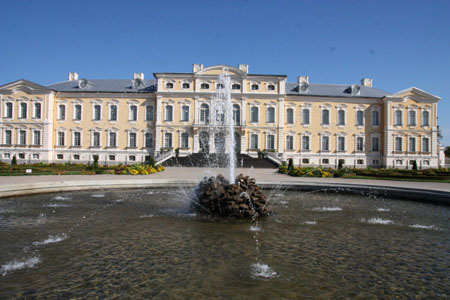 g
the palace we visit the village of Bauskas, where we have a very cheap, but
decent lunch. 14 euros for both of us.
g
the palace we visit the village of Bauskas, where we have a very cheap, but
decent lunch. 14 euros for both of us.
We drive back to Riga. Like everywhere in Latvia we see many cars parked
along the road, and people armed with a bucket walking off into the woods.
They appear to be looking for mushrooms. Back in Riga we have a rest and
then go to the old town to drink coffee and do some shopping. Later we enjoy
a cocktail at one of the many terraces at the Cathedral Square.
In the evening we have dinner at the Lidojosa Varda (the flying frog). We
sit outside on the pavement. It is near the hotel, in the Centrs
neighborhood where many of Riga's famous Art Nouveau buildings are located.
Enjoyed our dinner (salmon, pasta) with a good Australian white wine.
Weather: sunny 22°C / 72°F
Monday 8 September 2014
Rīga - Košrags: 172km; 2:30 u.
.jpg) range of resorts just outside Riga along the Gulf of Riga, where we took the
train to nine years ago. We
take this road because the Rough Guide promises a fun ride along the coast,
but that is a bit disappointing. The Gulf of Riga is hidden from view,
either by houses or by a dense pine forest, which seems to run all the way
to the waterline. We drive to Mersrags where we change course towards our
next accommodation in Kosrags on the Baltic Sea Side of the peninsula
separating the Gulf from the sea. Due to a mistake when entering the
coordinates into our navigation, we make a big detour, until we noticed that
something is not right. We fill in the appropriate information and then
after four hours of driving we finally get there. Our accommodation, at
Guesthouse Pitagi in Košrags, is in a cottage, but it's a bit simpler than
we had hoped. The furniture is a bit of jumble picked together at a flea
market and the room is filled with a table, sofa and beds, while the upper
floor is not accessible. The owner is friendly and speaks limited German.
She will make breakfast for us tomorrow.
range of resorts just outside Riga along the Gulf of Riga, where we took the
train to nine years ago. We
take this road because the Rough Guide promises a fun ride along the coast,
but that is a bit disappointing. The Gulf of Riga is hidden from view,
either by houses or by a dense pine forest, which seems to run all the way
to the waterline. We drive to Mersrags where we change course towards our
next accommodation in Kosrags on the Baltic Sea Side of the peninsula
separating the Gulf from the sea. Due to a mistake when entering the
coordinates into our navigation, we make a big detour, until we noticed that
something is not right. We fill in the appropriate information and then
after four hours of driving we finally get there. Our accommodation, at
Guesthouse Pitagi in Košrags, is in a cottage, but it's a bit simpler than
we had hoped. The furniture is a bit of jumble picked together at a flea
market and the room is filled with a table, sofa and beds, while the upper
floor is not accessible. The owner is friendly and speaks limited German.
She will make breakfast for us tomorrow.
We drive back to the cottage. A sunset photo is not on the cards tonight
because the sky has become overcast.
Weather: sunny 24°C/75°F
dinsdag 9 September 2014
The owner of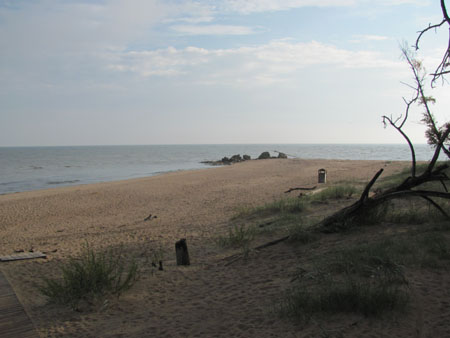 the cottages brings our breakfast at 8:30. It totally exceeds our
expectations. Meats, cheeses, an omelette, three kinds of jam, salad, a kind
of pizza rolls and fresh coffee. Unbeatable! After breakfast she comes back
to collect the dirty dishes. We then drive to Cape Kolka, where the Gulf of
Riga joins the Baltic Sea. We have to pay for parking the car! A bit
surprising - to say the least - in a region where the main road sees no more
than one car driving past every 30 minutes. We walk from the parking lot to
the beach and on to the point where the streams meet. It is low tide, so
at the moment it not looks very spectacular. It must be very different at
high tide if the photos in the souvenir shop are to be believed. We take a
walk on the beach along the Baltic Sea Side and then go into the forest. A
beautiful forest with beautiful mosses and many mushrooms. The mushrooms is
what many Latvian old ladies come here for to pick donning their orange
plastic buckets. We walk around and return to the parking lot. The cafeteria
/ shop is open and we take a coffee. Then we drive to the village of Kolka,
but that
the cottages brings our breakfast at 8:30. It totally exceeds our
expectations. Meats, cheeses, an omelette, three kinds of jam, salad, a kind
of pizza rolls and fresh coffee. Unbeatable! After breakfast she comes back
to collect the dirty dishes. We then drive to Cape Kolka, where the Gulf of
Riga joins the Baltic Sea. We have to pay for parking the car! A bit
surprising - to say the least - in a region where the main road sees no more
than one car driving past every 30 minutes. We walk from the parking lot to
the beach and on to the point where the streams meet. It is low tide, so
at the moment it not looks very spectacular. It must be very different at
high tide if the photos in the souvenir shop are to be believed. We take a
walk on the beach along the Baltic Sea Side and then go into the forest. A
beautiful forest with beautiful mosses and many mushrooms. The mushrooms is
what many Latvian old ladies come here for to pick donning their orange
plastic buckets. We walk around and return to the parking lot. The cafeteria
/ shop is open and we take a coffee. Then we drive to the village of Kolka,
but that is disappointing. There is only a post office and two supermarkets. We buy
stamps and post cards. We drive back to our cottage where we eat the
leftovers from our breakfast as lunch.
is disappointing. There is only a post office and two supermarkets. We buy
stamps and post cards. We drive back to our cottage where we eat the
leftovers from our breakfast as lunch.
In the afternoon we take two bikes, which are available to the guests of the
Guest House and ride through the woods behind the dunes from Košrags to
Vaide. Some of the bikes are cast-offs from the Hoge Veluwe National Park in
the Netherlands! The Dutch stickers with the original instructions are still
on them. The route passes through the Liv-hamlets along the coast and runs
along unsurfaced forest paths. A nice route and we do not meet anyone. In
Vaide we head back to main road, the P124, and ride back to Košrags. We take
a rest, take a shower and drink a cup of tea. It starts to rain outside and
quite heavily so. By five o'clock we take the car to Dundaga, where
this time we eat in the pub. It is a type of pub that belongs to the local
hotel. We are the only guests. WhenErik orders a glass of wine a mild panic
breaks out, because they apparently have no desire to open up a bottle for
just one glass. But fortunately they do have small bottles too. They
have one English menu, but the waitress has problems reading it. By
comparing the prices between the English and Latvian menu we manage to get
our order together. It tastes reasonably well for a place like that. When
return it starts raining again.
Weather: sunny 22°C / 72F°. In the afternoon it starts
to rain and temperatures drop to 16°C / 61°F
Wednesday 10 September 2014
Košrags - Liepaja: 182km / 113 mi; 2:30 hrs.
We get a filling
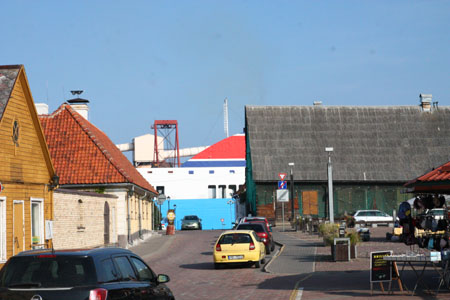 breakfast
from our hostess. This time with pancakes. It is more than we can manage to
eat. We drive away under the cover of rain and drive over the empty main
road to Ventspils. During the ride it clears up and the sun
starts to shine. Patches of fog emerge from the evaporating rainwater. In
Ventspils we park the car near the Town Hall Square. We walk along the
Nicholas Church, which we pay a brief visit. The church has a classical look
and it looks as of an observatory has landed on its roof. We drink coffee in
a small coffee shop. I pay the 2.70 euro with a note of five, but that seems
to be a problem. The lady behind the counter has to go to her neighbors - a
"general store" - to get change. We walk on and get tn the market. A modest
place with a covered part where meat and vegetables are sold. The
neighborhood around the market consists of traditional wooden houses with
traditional cobbled streets. Still further down, we are a few blocks away
from the seaport, which is located in the middle of town. Here we see coal
being loaded into ships on
breakfast
from our hostess. This time with pancakes. It is more than we can manage to
eat. We drive away under the cover of rain and drive over the empty main
road to Ventspils. During the ride it clears up and the sun
starts to shine. Patches of fog emerge from the evaporating rainwater. In
Ventspils we park the car near the Town Hall Square. We walk along the
Nicholas Church, which we pay a brief visit. The church has a classical look
and it looks as of an observatory has landed on its roof. We drink coffee in
a small coffee shop. I pay the 2.70 euro with a note of five, but that seems
to be a problem. The lady behind the counter has to go to her neighbors - a
"general store" - to get change. We walk on and get tn the market. A modest
place with a covered part where meat and vegetables are sold. The
neighborhood around the market consists of traditional wooden houses with
traditional cobbled streets. Still further down, we are a few blocks away
from the seaport, which is located in the middle of town. Here we see coal
being loaded into ships on  the
way to Rotterdam. We walk along the quay and arrive at the Livonian castle.
A medieval castle that was used as a prison later under the Russian Tsar. In
2001 it was restored in a grand way and it is now the historical
museum of the city. We walk back to the car and drive to the district of
Ostgals (port end). This is a nice, sleepy neighborhood near the harbor with
wooden houses and cobbled streets from the mid-19th century. The
neighborhood was once constructed to keep the expanding dunes in check. Not
all houses are equally well preserved and residents clearly belong to the
less wealthy. The city has done everything to make the public spaces in mint
condition.
the
way to Rotterdam. We walk along the quay and arrive at the Livonian castle.
A medieval castle that was used as a prison later under the Russian Tsar. In
2001 it was restored in a grand way and it is now the historical
museum of the city. We walk back to the car and drive to the district of
Ostgals (port end). This is a nice, sleepy neighborhood near the harbor with
wooden houses and cobbled streets from the mid-19th century. The
neighborhood was once constructed to keep the expanding dunes in check. Not
all houses are equally well preserved and residents clearly belong to the
less wealthy. The city has done everything to make the public spaces in mint
condition.
We then drive towards Liepaja. That's about two hours south
on the coastal road P122. We arrive around 12 noon. We stay in the Promenade hotel
on the banks of the Tirdzniecibas Kanals. It is a converted warehouse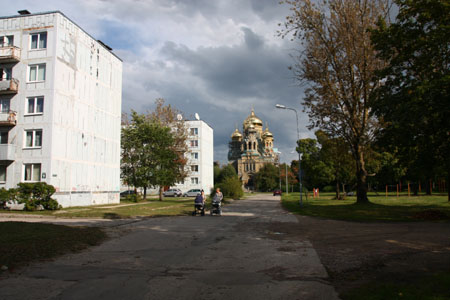 in the port area. We have lunch in the hotel restaurant. In the afternoon we
take the car to Karosta (meaning naval base). This district was created as a
Russian naval base in the late 19th century, meant as an outpost against the
rising German empire. The base was never tested, because in 1914 the Russian
Navy retreated to Tallinn and Helsinki at the outbreak of the First World
War and blocked the port of Karosta with sunken shipwrecks. The Soviets made
Karosta into a submarine base. In 1993, the Soviet army withdrew to Russia
and left the Russian civilian staff behind in this district. To get there we
need to cross the Kalpaks bridge. It is swing bridge with Art Nouveau
decorations on the lampposts. The bridge has opening times and we have to
wait more than 40 minutes. Only one ships passes the bridge. Once on the
other side, we see broad avenues along dilapidated military buildings from
the tsarist period and residential buildings in the worst Soviet style,
which are still inhabited by the Russians who stayed behind. It looks very
in the port area. We have lunch in the hotel restaurant. In the afternoon we
take the car to Karosta (meaning naval base). This district was created as a
Russian naval base in the late 19th century, meant as an outpost against the
rising German empire. The base was never tested, because in 1914 the Russian
Navy retreated to Tallinn and Helsinki at the outbreak of the First World
War and blocked the port of Karosta with sunken shipwrecks. The Soviets made
Karosta into a submarine base. In 1993, the Soviet army withdrew to Russia
and left the Russian civilian staff behind in this district. To get there we
need to cross the Kalpaks bridge. It is swing bridge with Art Nouveau
decorations on the lampposts. The bridge has opening times and we have to
wait more than 40 minutes. Only one ships passes the bridge. Once on the
other side, we see broad avenues along dilapidated military buildings from
the tsarist period and residential buildings in the worst Soviet style,
which are still inhabited by the Russians who stayed behind. It looks very 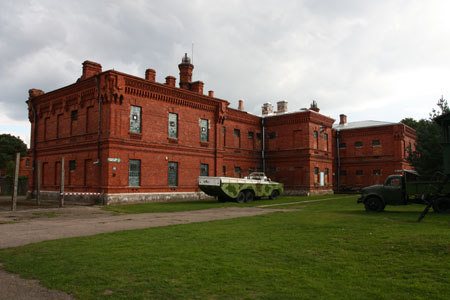 sad.
Between all that sadness stands the very proud Alexander Nevski Cathedral.
It is a gleaming Russian Orthodox cathedral with gigantic domes. The church
is not particularly nicely decorated on the inside, but it is filled with
icons. A handful of believers worships the icons. We move to the
military stockade. Here you can join a tour every hour. The next (and
last) one starts at 17 o'clock. We are 45 minutes early and get the tip to
go to the "manege" This dilapidated building served in the Czarist time as
stables and as a riding school where an equestrian show was given by the
cavalry horses every Sunday. The building dates from 1903. On the walls
large photos have been put up showing Karosta then and now. Interesting.
sad.
Between all that sadness stands the very proud Alexander Nevski Cathedral.
It is a gleaming Russian Orthodox cathedral with gigantic domes. The church
is not particularly nicely decorated on the inside, but it is filled with
icons. A handful of believers worships the icons. We move to the
military stockade. Here you can join a tour every hour. The next (and
last) one starts at 17 o'clock. We are 45 minutes early and get the tip to
go to the "manege" This dilapidated building served in the Czarist time as
stables and as a riding school where an equestrian show was given by the
cavalry horses every Sunday. The building dates from 1903. On the walls
large photos have been put up showing Karosta then and now. Interesting.
The tour in the stockade or
prison is given by an older man donning a Soviet uniform. He leads us
through the complex, which was originally b.jpg) uilt
as a hospital, but came in handy as correction facility for naughty soldiers
and sailors. They were sent here for minor punishments for disciplinary
offenses. The regime was very strict. During the German occupation deserters
imprisoned here. The serious cases were executed in a forest in front of the
prison. The Soviets also used the building as a disciplinary facility until
1991. The newly founded Latvian army used the building until 1997, when it
was closed because it did not meet NATO standards. It stood empty until
2002, when it became a museum. We see original military objects, the room of
the commander, an interrogation room and the cells.
uilt
as a hospital, but came in handy as correction facility for naughty soldiers
and sailors. They were sent here for minor punishments for disciplinary
offenses. The regime was very strict. During the German occupation deserters
imprisoned here. The serious cases were executed in a forest in front of the
prison. The Soviets also used the building as a disciplinary facility until
1991. The newly founded Latvian army used the building until 1997, when it
was closed because it did not meet NATO standards. It stood empty until
2002, when it became a museum. We see original military objects, the room of
the commander, an interrogation room and the cells.
In the evening we eat in town at Pastnieka Maja, a former post office. Quite
nice.
Weather: Morning rain and 8°C / 46°F.
Afternoon sunny and 19
donderdag 11 September 2014
We walk into  town
to the Trinity Church with its four-layer tower. Unfortunately, the church
is still closed (until 10am). We walk on into the old town and see the house
where Peter the Great spent the night on his Great Embassy tour in 1697. The
embassy was a word for a diplomatic mission led by Peter the Great for one
and a half years visiting a number of West European countries, including the
Netherlands. The building here (half timber) is sadly boarded up. Only a
plaque commemorates this historic event. Ten years after his visit Peter
came back to conquer the city. We walk to the Lutheran church, which
unfortunately is closed until 11am. In front of the door we meet an
Australian couple. The parents of the woman were married in this church in
1940. The woman is of German origin, but she is very reticent about that
fact. Her family fled for the Soviets to Germany at the end of the War. We
walk on to the lively market. We see sellers of mushrooms there. This is
apparently the result of their quests in the woods with the orange buckets.
There are also vendors with small
town
to the Trinity Church with its four-layer tower. Unfortunately, the church
is still closed (until 10am). We walk on into the old town and see the house
where Peter the Great spent the night on his Great Embassy tour in 1697. The
embassy was a word for a diplomatic mission led by Peter the Great for one
and a half years visiting a number of West European countries, including the
Netherlands. The building here (half timber) is sadly boarded up. Only a
plaque commemorates this historic event. Ten years after his visit Peter
came back to conquer the city. We walk to the Lutheran church, which
unfortunately is closed until 11am. In front of the door we meet an
Australian couple. The parents of the woman were married in this church in
1940. The woman is of German origin, but she is very reticent about that
fact. Her family fled for the Soviets to Germany at the end of the War. We
walk on to the lively market. We see sellers of mushrooms there. This is
apparently the result of their quests in the woods with the orange buckets.
There are also vendors with small blueberries.
All hand picked. Many of them seem to be Gypsies or Roma. There is also a
covered area with meat, vegetables, cheese and fish. At the butchers we see
completed and half pig heads on display. It is all quite cheap.
We then visit the Roman Catholic Church Josef which is behind the market.
The church is richly decorated with frescoes and murals. There is even a
chapel in Art Nouveau style. Next we walk to the Alexander Nevski Church,
the Orthodox Church, which is painted in purple and lilla. From there it is
a few hundred meters to the Hika iela with stone and wood Belle Epoque
villas in various states of repair and renovation. The municipality has
landscaped the streets beautifully with gardens, fountains and nice paving.
Now the houses will have to match that. We walk back to the Trinity Church,
which is now open. The dirty outside says very little about the rich rococo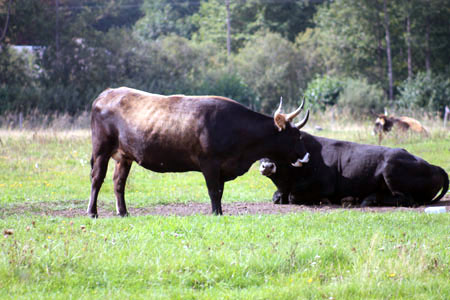 interior, which looks impressive. Much gold leaf has gone into the
altarpiece and the pulpit, which is supported by an atlant.
interior, which looks impressive. Much gold leaf has gone into the
altarpiece and the pulpit, which is supported by an atlant.
In the afternoon we drive to the National Park around
Lake Pape. There in the park, a
herd of wild Konik horses is roaming around. After some searching, we
get to the fenced off part of the national park. There is no guide at the
entrance office next to a closed gate and in the distance we see some horses
wandering. According to the signs a visit to the area without a guide is
strictly prohibited. We do it secretly and walk a little past the fence and
photograph the horses from a large distance. When we get back to the car and
call the number for the guide (+371 2 6693867), we see in the distance a
jeep driving towards us. It is the guide. For 6 euros she leads us into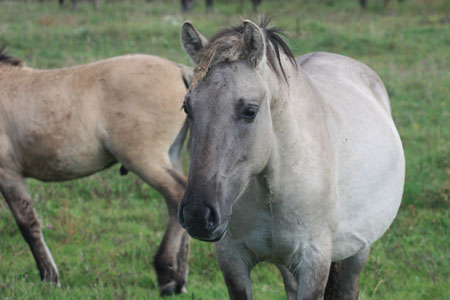 the herd of Konik horses and aurochs. We can approach them at very close
range. Sixteen horses have been imported from the Oostvaardersplassen in the
Netherlands. Out of the original 16 animals a herd of 150 horses has
grown in 15 years time. The horses are wild, but not very shy. They ignore
the visitors, but they keep an eye out for us. Touching and feeding is
strictly prohibited. In winter they are fed (the area is too small to
support them) and holes are made in the frozen lake. The aurochs live
peacefully alongside the horses. After half an hour we drive back to
Liepaja.
the herd of Konik horses and aurochs. We can approach them at very close
range. Sixteen horses have been imported from the Oostvaardersplassen in the
Netherlands. Out of the original 16 animals a herd of 150 horses has
grown in 15 years time. The horses are wild, but not very shy. They ignore
the visitors, but they keep an eye out for us. Touching and feeding is
strictly prohibited. In winter they are fed (the area is too small to
support them) and holes are made in the frozen lake. The aurochs live
peacefully alongside the horses. After half an hour we drive back to
Liepaja.
In the afternoon we drink a beer at
Darbnica,
an alternative style café on Liela iela. In the evening we eat at
Vecais Kapteinis.
The restaurant is in a restored wooden villa and even has a garden. I take
Ukranian carpacio of bacon with a glass of vodka followed by duck. Erik
takes a salad, followed by a pasta with chicken.
Weather: cool morning with fog. Then sunny with temperatures up to 21
degrees.
|
|
Other Travel |
|
| back | continue |